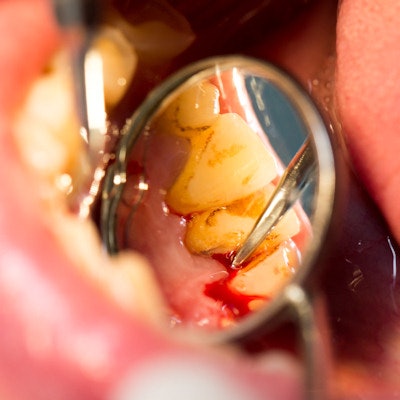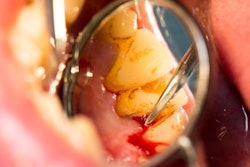
Is a nonsurgical treatment approach successful when treating patients with periodontal pocket depth of 5 mm or more? A retrospective study of more than 1,100 patients sought to find out.
Nonsurgical treatment that included oral hygiene instruction, scaling and root planing, and more was only successful in reducing pocket depth to 5 mm or less in about a third of the patients, the researchers reported (International Journal of Dental Hygiene, April 3, 2019).
"Active nonsurgical periodontal therapy in patients with adult periodontitis resulted in approximately one-third of the cases in the success end point" of periodontal pocket depth of less than 5 mm, wrote the authors, led by G.A. van der Weijden of the Clinic for Periodontology Utrecht in the Netherlands.
Pocket depths
The goal of periodontal therapy is to preserve, improve, and maintain the natural dentition. In this retrospective study, the results of active nonsurgical periodontal therapy in a clinic restricted to periodontology were evaluated. The researchers aimed to evaluate the results of this treatment in patients diagnosed with adult periodontitis and who were treated at one periodontology clinic.
More than 1,180 patients with adult periodontitis received active, nonsurgical therapy at the clinic. This treatment involved professional oral hygiene instruction, scaling and root planing, supragingival polishing, and elective systemic antimicrobial medication.
“Success following active nonsurgical periodontal therapy in patients with adult periodontitis is limited.”
A full-mouth periodontal chart was completed for each patient at evaluation. Following the intake appointment, the active phase of nonsurgical periodontal therapy was started. Dental hygienists were responsible for the tooth debridement and oral hygiene instructions. All patients received two to five one-hour sessions of thorough supra- and subgingival scaling and root planing of all teeth involved. A final evaluation was scheduled less than three months after the initial evaluation, and final measurements were taken.
The researchers defined successful treatment as periodontal pocket depth of 5 mm or less. Patient-related factors, including smoking and severity of periodontitis at baseline, and site-related factors, such as tooth type, furcation involvement, and endodontic treatment, were analyzed. At the initial evaluation, the researchers identified more than 660 teeth with an initial pocket depth around 9 mm.
Overall, 39% of the patients reached the successful treatment objective. The researchers noted that treatment success appeared to be dependent on tooth type:
- Single-rooted front teeth had a success rate of 85%.
- Premolar teeth had a success rate of 78%.
- Molar teeth had a success rate of 47%.
Also, smoking negatively influenced successful treatment outcome (p < 0.001), they added.
Baseline data
The authors listed several study limitations, the first of which was the retrospective analysis. They also reported that baseline pocket depth was not entered into the database, which would have allowed for a more precise measurement of treatment success. They noted, however, that each patient in the study had been referred to the clinic because their general dentist was unable to effectively treat their periodontal disease. In addition, the number of cigarettes smoked was not included.
Nevertheless, this study was one of the largest periodontal studies on record involving patients from one clinic, according to the authors.
"Success following active nonsurgical periodontal therapy in patients with adult periodontitis is limited," the researchers concluded. "Dental care professionals should consider this when they estimate the prognosis of teeth and molars."



















